Q&A – Ask Neil: June 22, 2023
(Please read these instructions carefully.)
Before you post your question, please look at recent issues to see if someone else has already asked it. You might find your answer there.
How to submit your question…
- Click the link provided below to post your question. After you submit your question, a new window will pop up giving you the address to which you can e-mail a sharp, high-resolution photo to accompany your question. Please do not send thumbnail photos in case I need to zoom in to see things.
- Click here to post your question.
- Please only post your question one time. We can only accept a set number of questions each week, and when we get duplicates it costs other people their chances.
- One question per reader, please.
- Please use this only for posting questions – not for standard emails.
- Watch for your answer in the following week’s e-gardens.
- I choose those of greatest general interest. For example, plant IDs seldom make the cut.
- I must have your first name or initials.
- I must have your city or county. (Texas is a very large state.)
QUESTION 1
WHAT SHOULD WE DO WITH THESE SPROUTS AT THE BASE OF OUR CRAPE MYRTLE?
Question: What should we do with these sprouts at the bottom of this crape myrtle? Our arborist recommended not cutting them, but it’s unsightly. Wayne Y., Richardson.
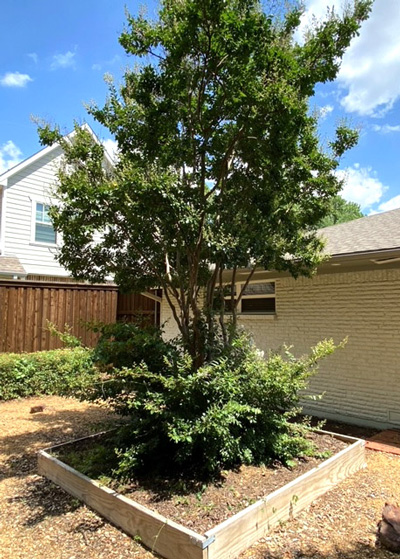
Answer: They should be removed flush with the trunk. All crape myrtles are genetically shrubs. We have been training larger varieties tree-form since about 1960. That’s the way your plant was initially trained. It has tried to reassume its genetic position as a shrub by sending out these multitudes of sprouts as most crape myrtles will do, at least for a few years. It’s up to us to remove them to maintain the tree-form habit. (If you wanted a shrub, you’d be better off cutting the plant to the ground and letting all the shoots sprout out and develop, but that’s not what most people would suggest here.)
Your arborist may have suggested leaving these because many crape myrtles in the Metroplex were hurt by the Christmas 2022 freeze. Many have struggled to leaf out. We on the Crape Myrtle Trails of McKinney board have recommended leaving the sprouts long enough to determine if the tops were healthy and vigorous before removing them. That might have been your arborist’s mindset. But your plant is doing just fine, so go ahead and remove the sprouts now. No pruning sealant is needed.
QUESTION 2
WHAT ARE THE ODDS FOR SURVIVAL OF A 60-YEAR-OLD OAK TREE THAT WAS HIT BY LIGHTNING?
Question: My 60-year-old oak tree was hit by lightning several days ago. What are its survival chances, and how can I help it? Kelley R., Irving.
Answer: I have a friend who was struck by lightning, and he talks about the experience. I have read about others who have not survived. The same is true for trees. There is a magnificent pecan tree 1 mile down the county road from our house. It was struck by lightning and its bark and trunk were split. But in the past 20 years that tree has healed and it is growing beautifully today. Other trees are splintered into 1000 pieces. Your best bet is to have a certified arborist look at the tree as soon as possible. My advertisers in e-gardens, Arborilogical Services, would be my first choice for trees in the Metroplex.
QUESTION 3
WHAT IS EATING OUR REDBUD TREE?
Question: We have a year-old redbud tree. Something seems to be eating its leaves, but we find no caterpillars. What would be doing this, and how concerned should we be? Brooke G., Richardson.
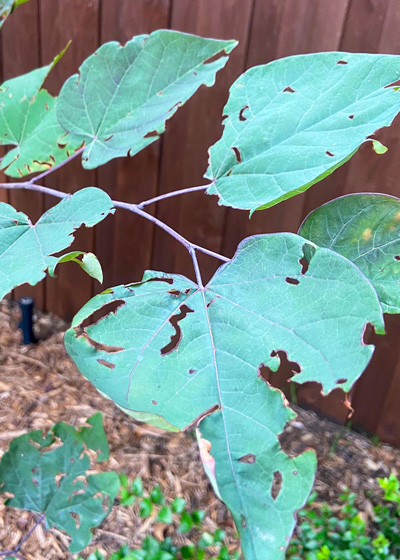
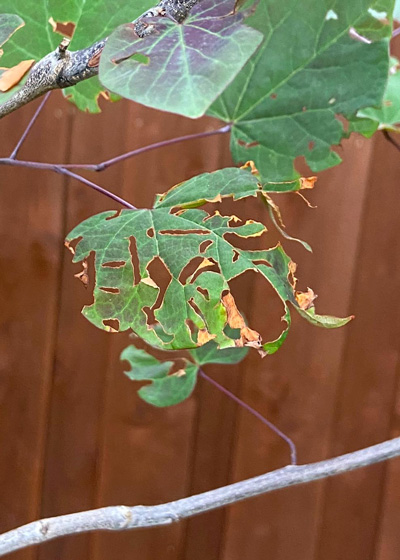
Answer: I’ve just spent 30 minutes with my buddy Siri looking for all pests related to “redbuds” or “Cercis canadensis” (scientific name for the tree). I especially wanted to see if there is a leaf miner, because I’m pretty sure that’s what is going after your tree. I have redbuds, too, and they’ve shown these same symptoms every summer for years. It never seems to weaken the trees much, and they come back to bloom just fine the following springs.
Leaf miners are larvae of small flies. They tunnel through the inner tissues of leaves cutting off the supply lines of water and nutrients in the process. Sometimes they reconnect with their starting points, and that allows the dead tissue to dry and fall out. Other times they do a partial job and a flap of dead leaf tissue is left in place.
I guess you could use the systemic insecticide Imidacloprid as a soil drench once the plant has finished flowering in early spring in advance of the miners’ arrival, but that shouldn’t be necessary unless the tree is highly visible and heavily bothered. Watch it for the rest of this year and make your determination for 2024.
QUESTION 4
WHAT CAN I DO TO CONTROL WHITEFLIES ON MY HARDY HIBISCUS AND MINT?
Question: I have a whitefly problem on my hardy hibiscus and mint plants. Last year I used fire ant killer mixed with water, and Dawn dishwashing soap with water. I drenched them every couple of weeks. What can I do? Tesh B., Aubrey.
Answer: Look for products that are legally labeled for control of whiteflies. That’s especially important since mint (an edible crop) is involved. I’m not aware of any fire ant remedy that could be used that way. Whiteflies are some of the most difficult insects to eliminate. They are always present in multiple stages of their life cycles, so repeated treatments will be needed. Yellow sticky traps may also attract them and help in reducing their populations, although the traps will also capture harmless and even beneficial insects. Get rid of all dead waste this winter to reduce over-wintering spots for the pests.
QUESTION 5
WHAT IS THE WHITE MOLD GROWING ON TOP OF MY MULCH?
Question: What is the white mold that is growing on top of my mulch? How do I get rid of it? Leslie S., Princeton.
Answer: You would need a mycologist to identify it specifically, but in general terms, it is a saprophytic fungus. That means that it is existing off the decaying organic matter. It is harmless to your living plants. Some of these molds can make a leathery layer that might repel water, so in those cases, it would help to break them open with a rake or hoe. You can apply dusting sulfur to kill the fungus, but keep it out of your eyes and off the leaves of tender plants.
QUESTION 6
YOUR ADVICE NOT TO RAISE THE MOWER HEIGHT IN SUMMER SEEMS TO CONTRADICT OTHERS. CAN YOU COMMENT?
Question: You advise not to let a lawn grow higher during the summer. I was surprised to learn that the San Antonio Water System contradicts that: https://www.gardenstylesanantonio.com/garden-tips-blog/the-long-and-short-of-mowing/. Can you comment on this? Carol D., Brenham.
Answer: I’d be happy to. This is my long-held opinion based on personal observation and from hanging out with some brilliant turf experts.
As grass is allowed to grow taller its blades extend upward as they compete for sunlight. The grass is not as dense, so more sun hits the soil. That allows the soil to dry out more rapidly.
Also, our turfgrasses in Texas (with the exception of tall fescue in the Panhandle) are spreading grasses with runners. If we keep the grasses cut lower – at the recommended mowing heights – they will produce more runners. Think about how dense and “tuft-like” bermudagrass is when it grows in cracks in a concrete road or alleyway where it is repeatedly run over by car tires.
My old Rule of Green Thumb: “Tall grass soon becomes weak grass.”
For what it’s worth, the mowing heights mentioned in this information from San Antonio aren’t much higher than what I suggest for normal lawn maintenance. It’s not like I’m suggesting “scalping” our lawns on a routine basis.
QUESTION 7
WHAT IS THIS AGGRESSIVE VINE?
Question: What is this aggressive vine? It makes little pods that look like lima beans. It grows on our shrubs and landscape beds, which makes it hard to spray the vine. Liz R., Hurst.
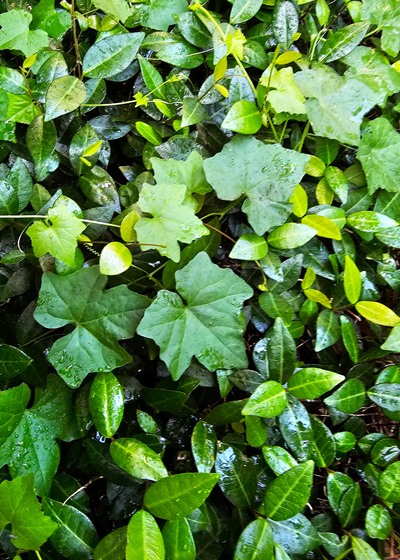
Answer: I have found over the years that most folks who ask for a plant identification of a weed are actually more interested in knowing how to control the weed than what its specific name is. Nonetheless, I spent 20 minutes trying to find this one for you because I have it as well. I couldn’t find an exact match for the leaf shape. There are several of these vines that are similar in looks.
The answer to the unasked question about how to control it is that I reach down into the shrubs or groundcover and trace the wiry stems to where they emerge from the ground. I use either a narrow trowel or my asparagus knife (dandelion digger) to sever it an inch or two below ground. I cut the stem into pieces as best I can and remove most of it from the bed. I rarely have it come back.
QUESTION 8
WHAT CAUSED THESE SPOTS ON OUR EL TORO ZOYSIA LAWN?
Question: My husband mowed the yard Monday after the storm Sunday night (June 12). Then we noticed all the spots on the El Toro zoysia lawn. Do you have any idea what it could be? Candy G., Flower Mound.
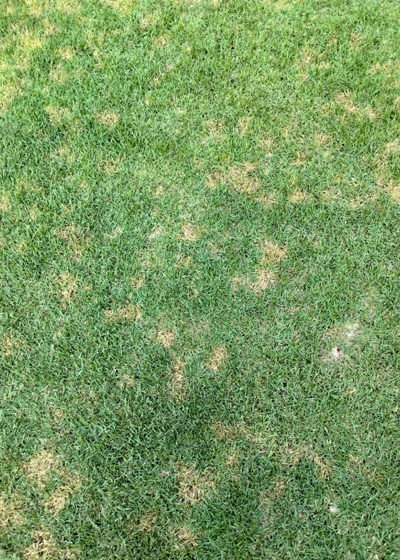
Answer: I’m going to take a wild guess that I’ve never uttered before in 53 years of answering gardening questions. I’m going to say that these are places where hailstones hit and melted. I don’t know if Flower Mound was one of those areas that received the really large stones, but this looks like grass that might have been subjected to freeze damage from having ice against it for however long it took it to melt. I don’t believe it was caused by any pathogen, and insects certainly don’t attack in these patterns. I’ll bet that the browned areas have started to recover by now.
QUESTION 9
WHAT HAS HAPPENED TO MY NEW NELLIE R. STEVENS HOLLIES? THEY HAVE TURNED BROWN VERY RAPIDLY.
Question: Please see the photos of my three 5-gal. Nellie R. Stevens hollies planted in November 2022. Each has a drip hose beneath a mulch layer. The soil is red clay. The leaves have rapidly turned brown and black and are falling off the plants. What’s up? Simon C., Flower Mound.
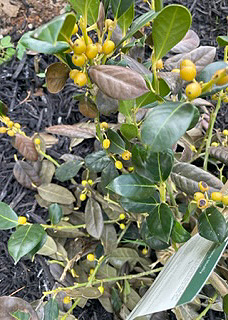
Answer: These plants got too dry one or more times this spring. Sadly, it’s a message I’ve had to repeat more often than I care to. The problem is that new plants have all their roots still intact in their original potting soil, and that potting soil is loose and highly organic. It dries out much more quickly than the surrounding soil. It’s easy to miss that fact, especially when it’s concealed by a layer of mulch. Plus, hollies really don’t wilt, so it’s doubly difficult to know when they’re dry. Drip irrigation and sprinklers simply are not enough. Not even close. That’s why you’ve seen me write and heard me say for the past several years my reformatted words from experience: we need to apply the same amount of water as the container from which the plant was planted. So, a 5-gallon Nellie R. Stevens holly should get 5 gallons of water, and it will need it every 2 days at current temperatures. As I always say, “Non-negotiable.”
QUESTION 10
SHOULD I SWITCH TO A BATTERY MOWER, OR MAYBE A REEL MOWER?
Question: For 20 years I had a great St. Augustine lawn, but for the past two years I’ve had bermuda. My mower leaves tire tracks on the yard and that grass dies in those tracks. I wonder if my 22-inch mower is too heavy? It’s 20 years old. I’m considering getting a lighter battery mower or perhaps a hand-push reel mower which is light. What would you suggest? Chia Liao, Little Elm.
Answer: If you want to Google this phenomenon, it’s called “heat-tracking.” Another reader asked about it several years ago, and I found a good write-up from Michigan State of all places. Odd it would show up from a northern state, but it even gets hot up there with their Kentucky bluegrass lawns.
I don’t think you’ll need to do anything drastic. The new battery-operated mowers are very good. If you’re in the market for a new mower, you might do some research on them. But I would absolutely not go with an old-fashioned reel mower. If you get into a rainy spell there are great odds that you won’t be able to push it through the lush grass. And, unless you have one of the low-growing hybrid bermudas developed specifically for golf greens, you won’t even need a powered reel mower. Try mowing early in the morning, and be sure the lawn has been watered deeply 24 or 36 hours prior to your mowing.
